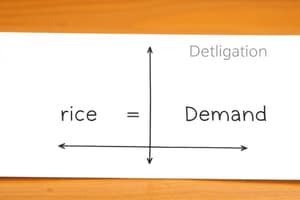Podcast
Questions and Answers
What does a high price elasticity of demand indicate?
What does a high price elasticity of demand indicate?
- Consumers only respond to price increases
- Consumers are not responsive to price changes
- Consumers change their behavior significantly with price changes (correct)
- Consumers do not change their behavior in response to price changes
In which scenario does a low price elasticity of supply occur?
In which scenario does a low price elasticity of supply occur?
- Price changes have a small impact on production (correct)
- Producers respond significantly to price changes
- Producers do not adjust their production based on price changes
- Producers always increase output regardless of price changes
What does a perfectly inelastic demand mean?
What does a perfectly inelastic demand mean?
- Consumers are extremely sensitive to price changes
- Quantity demanded is unaffected by price changes (correct)
- Quantity demanded changes proportionally less than price changes
- Consumers buy more when prices increase
When the price elasticity of supply is very high, what is likely to happen?
When the price elasticity of supply is very high, what is likely to happen?
What does a perfectly elastic demand suggest?
What does a perfectly elastic demand suggest?
How does cross-price elasticity differ from price elasticity of demand?
How does cross-price elasticity differ from price elasticity of demand?
In cases of perfectly inelastic demand or supply, what happens when there is a change in price?
In cases of perfectly inelastic demand or supply, what happens when there is a change in price?
Which of the following is a factor affecting perfectly inelastic demand?
Which of the following is a factor affecting perfectly inelastic demand?
What does perfectly elastic demand imply?
What does perfectly elastic demand imply?
Which of the following is a factor affecting perfectly inelastic supply?
Which of the following is a factor affecting perfectly inelastic supply?
What happens when a good has perfectly elastic supply?
What happens when a good has perfectly elastic supply?
Which of the following is a factor that can influence perfectly elastic demand?
Which of the following is a factor that can influence perfectly elastic demand?
If the demand for a product is perfectly inelastic, what is likely to happen when the price increases?
If the demand for a product is perfectly inelastic, what is likely to happen when the price increases?
What does a perfectly elastic supply imply?
What does a perfectly elastic supply imply?
Which of the following is NOT a factor that can influence perfectly elastic supply?
Which of the following is NOT a factor that can influence perfectly elastic supply?
What is a characteristic of a perfectly inelastic demand?
What is a characteristic of a perfectly inelastic demand?
Flashcards are hidden until you start studying
Study Notes
Supply and Demand Elasticity
Price Elasticity of Demand
Price elasticity of demand measures the responsiveness of quantity demanded to changes in market prices. When the price elasticity is high (-1 < E > 1), it means consumers change their behavior more as a result of price changes, indicating a relatively greater response from consumers to price changes. This can lead to either increase or decrease in total revenue depending on whether the price rises or falls. On the other hand, if the price elasticity is low (E close to zero or |E| < 1), consumer behavior changes less with respect to price changes, implying that small price changes do not significantly impact sales.
Price Elasticity of Supply
The price elasticity of supply assesses the responsiveness of producers to price changes when determining how much they produce and sell. If the price elasticity of supply is very high (E >> 1), this indicates a large shift in supply due to changes in price, which may cause shortages or surpluses. Conversely, if the price elasticity of supply is very low (E<<1), there is only a small proportionate change in quantity supplied with respect to price changes.
Cross-Price Elasticity
Cross-price elasticity examines the relationship between different goods and services by measuring how one product's price changes affect the demand for another good or service. In this case, if goods are substitutes, an increase in the price of one will lead to an increase in the demand for the other; conversely, if they are complementary goods, a decrease in the price of one will boost the demand for the other and vice versa.
Perfectly Inelastic and Perfectly Elastic
In economics, two special cases of price elasticities are mentioned - perfectly inelastic or perfectly elastic demand. These concepts are utilised to analyze extreme situations where all buyers buy or none buy a certain product regardless of its price. For example, if a person needs oxygen to survive, they would continue buying it even if the price increases infinitely, making the demand perfectly inelastic (-∞ < E < 0). Alternatively, if a luxury item has become so expensive that nobody can afford it, the demand becomes perfectly elastic (E = ∞). Similarly, perfect inelasticity applies when a firm cannot reduce production below or above a fixed level despite any changes in price.
Studying That Suits You
Use AI to generate personalized quizzes and flashcards to suit your learning preferences.




